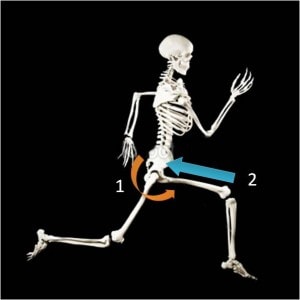The Hip Bone is Connected to the Knee Bone: Patellofemoral Pain in Running
One of the things that’s often missing from modern medicine is a realization that a problem at one joint without pain may be causing another joint to experience pain–the old hip bone’s connected to the knee bone.
In that same vein, there was an interesting study published this week on knee cap pain (patellofemoral syndrome) in women runners. This study has implications for how physical therapists should prescribe patellofemoral pain syndrome exercises. The researchers wanted to see if weak gluteal muscles in the hip might have something to do with too much stress on the knee cap. They did find that in females with patellofemoral pain in running, the gluteal muscles were weaker and showed late activation.
How could weak and late firing butt muscles cause problems in the knee cap? See the diagram I created above. When you run and land on one leg, the butt muscles at #1 above need to contract to keep your hip and body from collapsing down. To understand this better, place your hand on your backside and try running in slow motion a few times. You’ll see as you land on one leg, the gluteal muscles of that side contract. Also note that at the same time, the quadriceps muscles need to contract to also prevent you from collapsing (#2 above). To see this for yourself, try slow motion running again with one hand on the butt muscles and one hand on the thigh muscles (don’t get caught doing this in the office or at home as an explanation may be in order). Since both of these muscles work together to support the hip and body as you land on that leg, if the butt muscles are weak or fire late, the quadriceps muscle has to contract extra hard to keep the hip from collapsing downward.
What lives at the end of the quadriceps muscle? The knee cap! The over contraction of the quadriceps causes the patella (knee cap) to be pulled extra hard against it’s groove, wearing down cartilage under the knee cap. If this problem goes on long enough without being fixed, the cartilage will wear out and patellofemoral arthritis will set in.
How can you fix this problem? You need to find out why the butt muscle is contracting late and is weak. This could be as simple as strengthening it, or as complex as an irritated nerve in your back causing the weakness in the gluteals (see our practice’s book, Orthopedics 2.0 for more information). See a qualified sports physician (one that will take the time to look at these issues rather than a 5 minute visit and a declaration that surgery is the only option). Also sports physical therapists or athletic trainers who understand biomechanics (both few and far between) are also safe bets. However, in particular, a lateral release surgery for the patella is not indicated for this problem, as cutting the supports around the knee cap would make little sense if the problem is really a “pain in the butt”!

NOTE: This blog post provides general information to help the reader better understand regenerative medicine, musculoskeletal health, and related subjects. All content provided in this blog, website, or any linked materials, including text, graphics, images, patient profiles, outcomes, and information, are not intended and should not be considered or used as a substitute for medical advice, diagnosis, or treatment. Please always consult with a professional and certified healthcare provider to discuss if a treatment is right for you.

